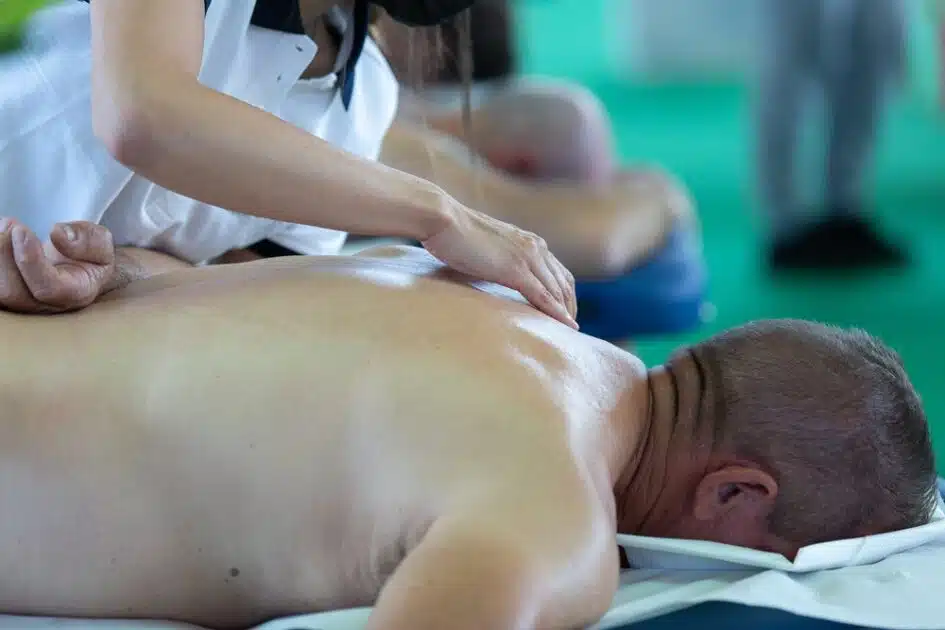Unleashing the Potential of Neuromuscular Massage: Discover the 7 Benefits

Ignite Your Body's Healing Power through Neuromuscular Massage
What is Massage 31st Jul, 2023
Neuromuscular massage therapy is a distinguished variant of manual massage, meticulously designed to alleviate muscular tension and enhance overall well-being. The therapy employs a unique combination of digital pressure and friction, tailored to target specific strain zones within muscle fibers.

These areas of tension, commonly referred to as tender or trigger points, have garnered a notorious reputation for being the root cause of persistent muscular discomfort. Trigger points manifest as miniature regions within the muscle tissue where unnatural contracture is observed. What makes these points particularly fascinating is their peculiar biological behavior.
Starved of adequate blood supply and deprived of essential nutrients, these contracted tissues fail to relax, thereby triggering a cycle of continuous muscular discomfort. Furthermore, these trigger points can induce referral pain, a curious phenomenon where the sensation of pain, tingling, or numbness radiates to regions far removed from the actual site of the trigger point.
The Science and Art of Neuromuscular Massage
Neuromuscular massage therapy, with its roots grounded in both art and science, is a manual therapy that places its focus on understanding and rectifying the complex interplay of muscles, nerves, and the skeletal system. This targeted approach towards muscle pain and dysfunction involves the application of concentrated, firm pressure on the identified trigger points, using a variety of tools such as fingers, knuckles, or elbows. It is the intricate balance of precision and technique, coupled with a comprehensive understanding of human physiology, that classifies neuromuscular therapy as both a science and an art.
The application of sustained pressure, ranging anywhere from 10 to 30 seconds, is a central technique in neuromuscular therapy. This method is designed to disrupt the cycle of pain-spasm-pain, which is frequently seen in chronic muscle tension. By maintaining pressure on the trigger point, the therapy aims to improve blood circulation to the affected region, facilitating the diffusion of oxygen and nutrients necessary for muscle relaxation and healing.

Interestingly, the science behind this therapy relies on the understanding that our muscles operate in groups. When one muscle is contracted, its opposite – the antagonist muscle – is forced to relax, a principle known as reciprocal inhibition. Neuromuscular therapists use this knowledge, along with their expertise in locating trigger points, to release tension and reduce pain.
However, the art of therapy is not solely focused on the technical delivery. It also encompasses the therapist’s ability to form an empathetic connection with their clients, to understand their unique pain patterns, and to adapt their techniques according to the individual’s needs. This personalized, client-centered approach, coupled with scientific methodologies, forms the crux of neuromuscular therapy.
Neuromuscular Massage from Deep Tissue Massage
It is not uncommon for deep tissue massage and neuromuscular massage to be mistaken for one another due to their shared focus on addressing muscle discomfort. However, these two modalities possess distinct characteristics and serve different purposes.

Deep tissue massage is widely recognized as an effective method for alleviating muscle tension and stress-related aches. It primarily aims to provide relaxation and temporary relief from daily life strains. By utilizing long, sweeping strokes and applying consistent pressure, deep tissue massage promotes relaxation and overall well-being.
On the other hand, neuromuscular massage techniques delve deeper into the realm of therapeutic intervention. These specialized manual therapy techniques take a more targeted approach to rectify pain and address movement dysfunctions by honing in on trigger points, muscle adhesions, and connective tissue patterns. Rather than solely focusing on surface-level tension relief, it aims to pinpoint and resolve the underlying causes of discomfort.
Neuromuscular massage therapy is grounded in the understanding that muscular pain and dysfunction can stem from various factors, including specific traumas, repetitive movements, or poor posture. Through a meticulous examination of the body’s musculoskeletal structure, a skilled therapist identifies and targets the trigger points responsible for the pain. By applying concentrated pressure to these trigger points, using techniques such as sustained digital pressure or friction, massage therapy promotes the release of tension and restores optimal muscle function.
Unlike deep tissue massage, which can be sought sporadically for relaxation purposes, neuromuscular massage is considered an ongoing treatment. It is intended to address chronic pain and movement dysfunctions by systematically working on the underlying issues over a series of sessions. By focusing on the root causes of discomfort, neuromuscular massage offers a comprehensive and therapeutic approach to restoring muscle health and functionality.
While deep tissue massage primarily serves as a stress-relieving technique, neuromuscular massage stands out as a specialized therapeutic modality. Through its highly targeted techniques and emphasis on resolving pain and movement dysfunctions, neuromuscular massage therapy presents a tailored and ongoing treatment option for individuals seeking lasting relief from chronic muscular issues.
Medical Conditions That Can Be Treated with Neuromuscular Massage
The use of neuromuscular massage therapy as a treatment for a variety of illnesses has been shown to be adaptable and successful. The following conditions’ pain can be efficiently addressed and reduced by this particular style of massage:

1. Low Back Pain
One of the most prevalent conditions affecting individuals, neuromuscular massage therapy provides targeted relief for the chronic pain that plagues the lower back region.
2. Upper Back Pain
By focusing on trigger points and muscle adhesions in the upper back, neuromuscular massage therapy offers relief from persistent discomfort and tension.
3. Carpal Tunnel-like Symptoms
Neuromuscular massage techniques can help alleviate the pain, numbness, and tingling often associated with carpal tunnel syndrome or similar conditions affecting the wrist and hand.
4. Sciatica-like Symptoms
The radiating pain and discomfort caused by sciatica, originating from the lower back and extending down the leg, can be addressed through targeted neuromuscular massage therapy.
5. Calf Cramps
Neuromuscular massage therapy can help release tension and restore proper function to the calf muscles, offering relief from painful cramping episodes.
6. Plantar Fasciitis
This common foot condition characterized by inflammation and pain in the heel and arch area can be effectively treated with focused neuromuscular massage techniques.
Recommended:
Massage for Plantar Fasciitis
7. Tendonitis
By targeting trigger points and addressing muscle imbalances, neuromuscular massage therapy can aid in the recovery and management of tendonitis, a condition characterized by inflammation and irritation of tendons.
8. Knee Pain
Neuromuscular massage therapy offers relief from knee pain caused by various factors such as muscle imbalances, tightness, or strain.
9. Jaw Pain
For individuals experiencing temporomandibular joint (TMJ) disorders or jaw pain, neuromuscular massage therapy can provide relief by addressing trigger points and tension in the jaw muscles.
10. Hip Pain
By targeting the muscles and trigger points surrounding the hip joint, neuromuscular massage therapy can alleviate discomfort and improve mobility in individuals experiencing hip pain.
The techniques used in neuromuscular massage therapy may be modified to treat additional musculoskeletal problems and their accompanying symptoms, demonstrating its adaptability beyond the ailments on this list. For the best outcomes, it is crucial to get advice from a knowledgeable professional who can evaluate unique situations and create a specialized treatment plan.
For people looking for therapeutic relief from a wide range of medical disorders, neuromuscular massage treatment stands as a beneficial therapeutic choice because of its capacity to target particular regions and address the underlying causes of discomfort.
Benefits of Neuromuscular Massage Therapy
Neuromuscular massage therapy holds immense potential for promoting overall well-being and improving the quality of life for individuals seeking relief from various musculoskeletal issues.
Patients undergoing this specialized form of massage can expect to experience a wide range of benefits that extend beyond the immediate alleviation of pain. Here are some of the key advantages of neuromuscular massage therapy:
1. Pain Reduction or Complete Elimination
One of the primary goals of neuromuscular massage therapy is to target and alleviate pain. By focusing on trigger points and releasing tension within the muscles, this therapy can significantly reduce or even eliminate persistent pain caused by muscular imbalances, trauma, or postural issues.
2. Enhanced Flexibility and Strength
Through the application of targeted pressure and friction, neuromuscular massage therapy works to release tension and restore optimal muscle function. This leads to increased flexibility, allowing for a wider range of motion, and improved strength, facilitating better muscular performance.
3. Improved Ease and Efficiency of Movement
As neuromuscular massage therapy addresses underlying muscular issues, it can enhance the ease and efficiency of movement. By restoring balance and harmony within the musculoskeletal system, individuals often experience smoother and more coordinated movement patterns.
4. Better Posture
Poor posture can lead to a variety of musculoskeletal problems, including back pain and discomfort. Neuromuscular massage therapy targets the muscles responsible for maintaining proper posture, helping to correct imbalances, and promoting better alignment of the body.
5. Balanced Musculoskeletal and Nervous Systems
Neuromuscular massage therapy aims to restore the balance between the musculoskeletal and nervous systems. By addressing trigger points and tension within the muscles, this therapy can improve communication and coordination between these systems, leading to enhanced overall functionality.
6. Improved Blood Circulation
The application of pressure and friction during neuromuscular massage therapy stimulates blood flow to the treated areas. This increased circulation helps deliver essential oxygen and nutrients to the muscles, aiding in their healing and promoting overall health.
7. Reduced Body Toxin Levels
Through the release of tension and improved circulation, neuromuscular massage therapy can facilitate the removal of toxins and metabolic waste products from the muscles. This detoxifying effect contributes to improved muscle health and overall well-being.
8. Increased Energy and Vitality
As the body’s musculoskeletal system is restored to a state of balance and optimal functioning, individuals often experience increased energy levels and a renewed sense of vitality. Neuromuscular massage therapy can help alleviate fatigue and promote a greater sense of well-being.

It is important to note that the benefits of neuromuscular massage therapy may vary from person to person, and the duration and frequency of treatment may also impact the extent of these benefits. Consulting with a qualified neuromuscular massage therapist can help determine an individualized treatment plan to maximize the advantages and optimize overall well-being.
Recommended:
Acupressure Massage
FAQs
What is neuromuscular massage?
It’s a form of soft tissue manipulation targeting underlying muscle and connective tissue to treat chronic pain and injuries.
How do you perform a neuromuscular massage?
By applying concentrated finger pressure to specific areas (trigger points) to relieve tension and spasms.
Purpose of the neuromuscular technique?
To balance the musculoskeletal and nervous systems, reducing pain and improving muscle function.
Different types of neuromuscular massage techniques?
Trigger point therapy, myotherapy, and ischemic compression are common techniques.
Is a neuromuscular massage painful?
It can be uncomfortable due to pressure on sensitive trigger points, but shouldn’t be intolerably painful.
The Bottom Line
Neuromuscular massage therapy emerges as a powerful and specialized modality within the realm of manual therapy. With its unique focus on targeting trigger points, muscle adhesions, and connective tissue patterns, it offers a comprehensive approach to addressing chronic pain, movement dysfunctions, and musculoskeletal imbalances.
Through the skilled application of concentrated pressure and friction, neuromuscular massage therapy aims to alleviate pain, improve flexibility, enhance movement efficiency, and restore balance to the body’s musculoskeletal and nervous systems. It goes beyond mere relaxation, delving deep into the underlying causes of discomfort to promote long-term healing and wellness.
The benefits of neuromuscular massage therapy extend beyond the physical realm. By reducing pain and tension, improving posture, enhancing circulation, and detoxifying the body, it can have a profound impact on overall well-being, vitality, and energy levels. Whether it is addressing low back pain, carpal tunnel-like symptoms, sciatica, or a myriad of other conditions, neuromuscular massage therapy offers a tailored approach to each individual’s unique needs.
















